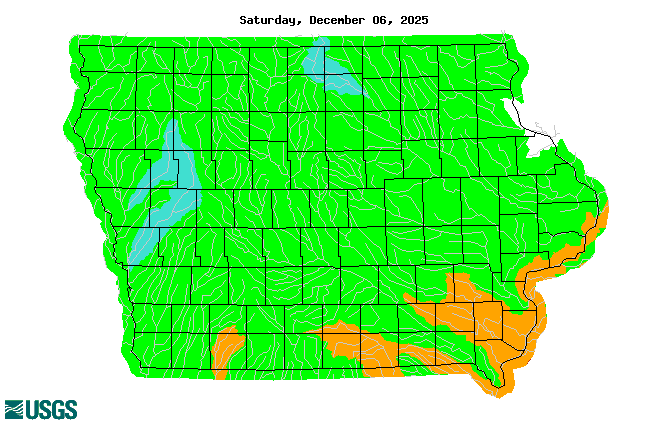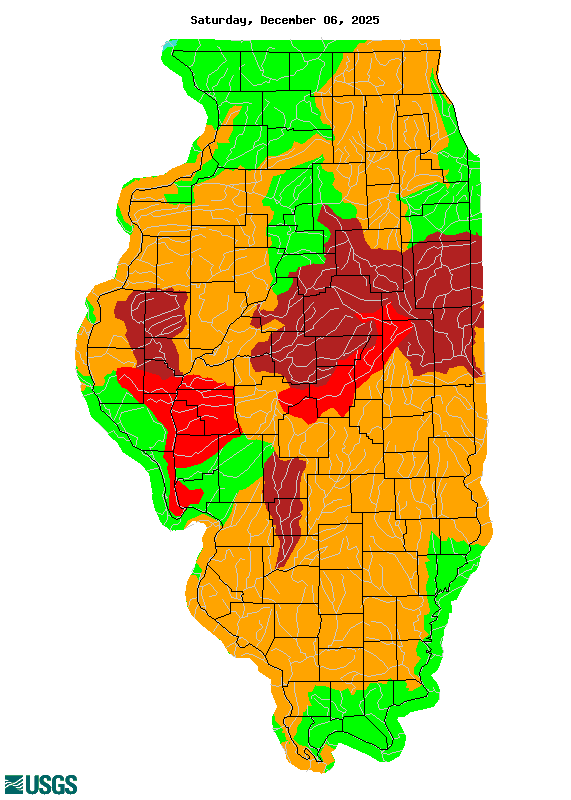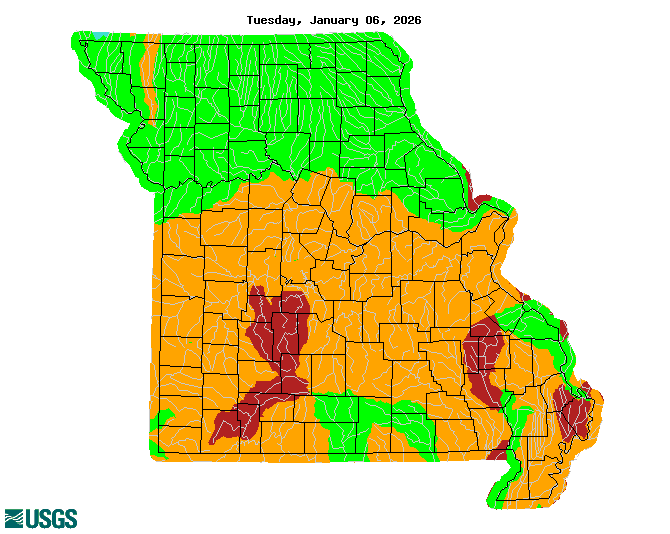 |
|
 |
Photos from Mike Ortiz
The Spring Flood and Water Resources Outlook is for the Quad Cities Hydrologic Service Area (HSA), which covers portions of eastern Iowa, northwest and west central Illinois, and extreme northeast Missouri.
This includes the Mississippi River from above Dubuque, Iowa to below Gregory Landing, Missouri and its tributaries.
The primary local river basins include the Maquoketa, Wapsipinicon, Cedar, Iowa, English, Skunk, North Skunk, and Des Moines Rivers in Iowa, the Fox River in Missouri, and the Pecatonica, Rock, Green, and La Moine Rivers in Illinois.
This outlook is for the time period from March through May.
Spring Flood Outlook Update
Key Points
Details
The spring flood risk is below normal for the Mississippi River and local tributary rivers across the NWS Quad Cities Hydrologic Service Area.
Some factors contributing to the current risk levels include:
1) Lack of a snowpack in the local area or in the headwater areas in Minnesota and Wisconsin.
2) Below normal soil moisture levels in the local area that will provide more potential storage for spring rains.
3) Lack of frozen soils in the local area or in the headwater areas to the north.
4) Local streams are currently flowing at, to below the normal level.
.Key Takeaways…
* Even though the overall risk of spring flooding is below average in the NWS Quad Cities HSA, this does not guarantee that high impact flooding will not occur. The severity of any flooding will be determined primarily by changes in the key factors mentioned above. In addition, we will be monitoring the outlooks for spring precipitation to see if that could become a contributing factor this year.
* Current lack of snow cover and well below normal snowfall this winter has greatly reduced the overall flood threat. In addition the snow water equivalent in the headwaters of the upper Mississippi River basin are well below normal, which will further decrease our likelihood of major impacts on the Mississippi River.
* Widespread below normal soil moisture levels in the local area increases the capacity of the soils to soak in spring precipitation and which will significantly mitigate the near term flood risk as well as decrease the risk for prolonged flooding.
* A significant snow melt occurred locally at the beginning of February and caused flood concerns across parts of western Illinois. Warmer and drier conditions prevailed after this, mitigating heightened stream flows and moistened soils. If warmer and drier conditions persist through March, this will likely reduce our spring flood threat further in the final outlook.
Many factors are considered when determining the overall flood risk for the upcoming spring season. The combination of these influences factor into the final determination. These factors are discussed in detail in the next few tabs and also in the Statistical Hydrological Outlook linked below.
________________________________________________________________________________________________________________
Use the links below to find the Graphical Probabilities and the Numerical Probabilities, respectively.
Current/Forecast River Conditions
| Current Conditions | Forecast Conditions | Long-Range Outlooks |
 |
|
Link To Advanced Hydrologic Prediction Service (AHPS) and Additional River Forecast Resources
Flood Category Definitions
What Are The Risk Factors For Flooding?
Many factors are have been considered when determining the overall flood risk for the Spring, with the combination of these influences factoring into the final determination. These factors are discussed in detail below.
Seasonal Precipitation
Precipitation in eastern Iowa, northwest Illinois and northeast Missouri has been near to slightly above average so far this winter. However, much of the Hydrologic Service Area (HSA), especially eastern Iowa, remains in some level of drought due to well below normal precipitation observed from the fall months in 2023. This is also well reflected in soil moisture levels (see below). North of the area, precipitation in the upper Mississippi River Basin so far this winter has averaged below normal, aside from parts of northern Minnesota.
.png) |
Below you will find graphics of the precipitation accumulated this winter season (left) and how this amount of moisture compares to normal in percentage (right). These graphics are courtesy of the Midwest Regional Climate Center.
(2).png) |
(2).png) |
River Conditions
Streamflow analysis from the United States Geological Survey (USGS) indicates the majority of the Upper Mississippi River watershed and tributary streamflows are below to near normal. Streamflows that are below normal levels would have more capacity to hold runoff from heavy rains.
 |
 |
 |
| Iowa | Illinois | Missouri |
| Images courtesy of the USGS |
Soil Conditions
Despite near to above normal precipitation values so far this winter, soil moisture levels remain below normal due to an extremely dry Fall. Latest analysis from the Climate Prediction Center shows soil moisture ranking profiles around 10-40% for the majority of the HSA, and also includes much of the upper Mississippi River Basin. This favors a decreased to neutral threat from this category for spring flooding, as drier soils will be better suited to soak in heavier rains.
| Image courtesy of the NWS Climate Prediction Center |
Snow Cover and Liquid Water Content
The Mississippi River Basin and the area tributaries are completely free of snow cover per the latest analysis from the National Operational Hydrologic Remote Sensing Center (NOHRSC). Although additional snowfall is possible early in the spring, the likelihood of developing a deep snowpack is low.
|
||||
|
||||
| Images courtesy of the National Operational Hydrologic Remote Sensing Center (NOHRSC) |
Frost Depth
| Frost Depths - North Central River Forecast Center | ||
Regional Frost Depths as of March 11, 2024 |
Ice Jam Flooding
The warmer weather this winter has largely limited the development of river ice. Bouts of colder air are possible through early spring, however, without a long period of extreme cold the development of river ice and ice jam flooding is unlikely.
Looking Ahead
While active weather patterns are typical of the spring months, this could lead to variations of warmer and colder temperatures, where the risk for flooding will be determined by the tracks of individual and multiple storm systems that could bring heavy rain or heavy snow to parts of the region.
According to the latest climate outlooks from the Climate Prediction Center, probabilities are leaning toward near normal temperatures for much of the region for the remainder of March, with a signal for somewhat above normal precipitation during the same timeframe.
The three month outlook for April through June is leaning toward a continuation of above normal temperatures for much of the region, with equal chances for precipitation being above, near or below normal.
Climate Outlooks
| 8 to 14 day Temperature Outlook | 8 to 14 day Precipitation Outlook |
 |
 |
|
Apr-May-Jun Temperature Outlook |
Apr-May-Jun Precipitation Outlook |
.gif) |
.gif) |
River and Streamflow Information:
Flood safety and flood insurance information:
Precipitation, temperature, and soil moisture information:
Questions or Comments
If you have questions or comments about this spring flood and water resource outlook please contact:
National Weather Service Quad Cities Hydrology Team
9040 Harrison St
Davenport, IA 52806
Email: cr.dvn-hydro@noaa.gov
 |
Media use of NWS Web News Stories is encouraged! Please acknowledge the NWS as the source of any news information accessed from this site. |
 |